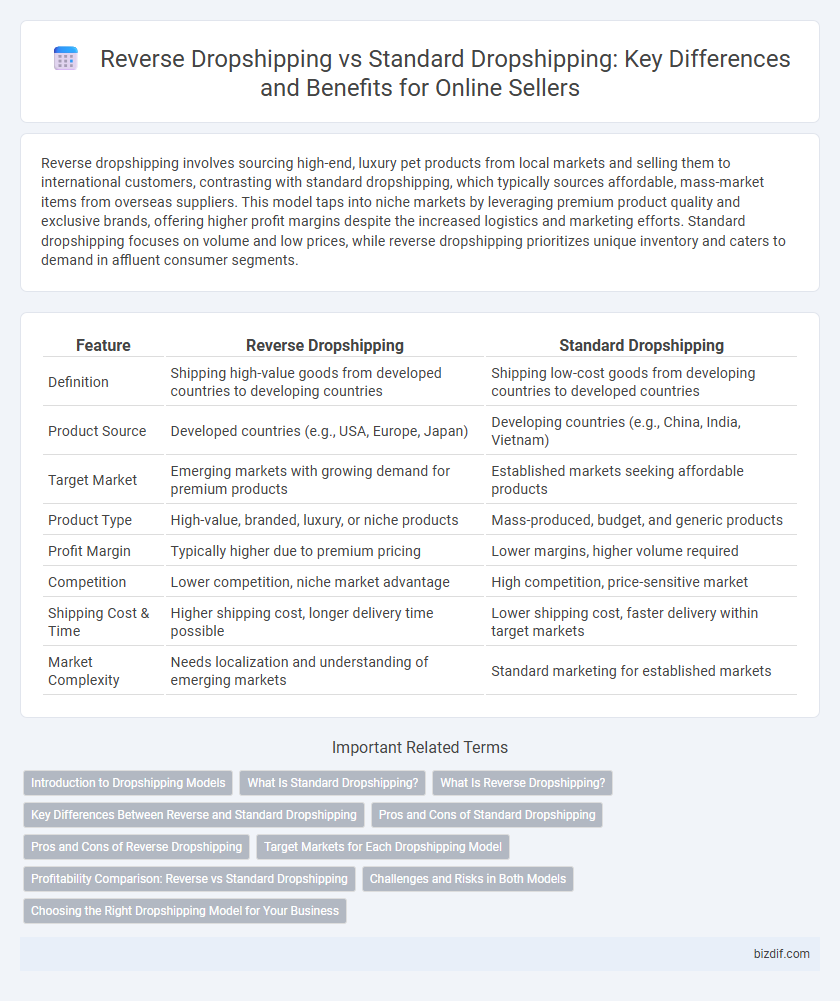Reverse dropshipping involves sourcing high-end, luxury pet products from local markets and selling them to international customers, contrasting with standard dropshipping, which typically sources affordable, mass-market items from overseas suppliers. This model taps into niche markets by leveraging premium product quality and exclusive brands, offering higher profit margins despite the increased logistics and marketing efforts. Standard dropshipping focuses on volume and low prices, while reverse dropshipping prioritizes unique inventory and caters to demand in affluent consumer segments.
Table of Comparison
| Feature | Reverse Dropshipping | Standard Dropshipping |
|---|---|---|
| Definition | Shipping high-value goods from developed countries to developing countries | Shipping low-cost goods from developing countries to developed countries |
| Product Source | Developed countries (e.g., USA, Europe, Japan) | Developing countries (e.g., China, India, Vietnam) |
| Target Market | Emerging markets with growing demand for premium products | Established markets seeking affordable products |
| Product Type | High-value, branded, luxury, or niche products | Mass-produced, budget, and generic products |
| Profit Margin | Typically higher due to premium pricing | Lower margins, higher volume required |
| Competition | Lower competition, niche market advantage | High competition, price-sensitive market |
| Shipping Cost & Time | Higher shipping cost, longer delivery time possible | Lower shipping cost, faster delivery within target markets |
| Market Complexity | Needs localization and understanding of emerging markets | Standard marketing for established markets |
Introduction to Dropshipping Models
Standard dropshipping involves retailers selling products sourced from low-cost suppliers, typically in countries like China, to customers in higher-priced markets such as the US or Europe, minimizing inventory risks and upfront costs. Reverse dropshipping flips this model by offering premium, high-value products from developed countries to consumers in emerging markets seeking luxury or specialized items. Both models require streamlined supply chain management but target different consumer segments and product categories to maximize profit margins.
What Is Standard Dropshipping?
Standard dropshipping is a retail fulfillment method where a store sells products without holding inventory, relying on suppliers to ship items directly to customers. This model reduces upfront investment and inventory risk by eliminating the need for warehouse space and order handling. It typically involves sourcing products from manufacturers or wholesalers in low-cost regions to sell at retail prices in higher-demand markets.
What Is Reverse Dropshipping?
Reverse dropshipping involves sourcing high-end products from low-cost countries and selling them in high-demand, affluent markets, contrasting with standard dropshipping where affordable products are shipped from low-cost suppliers to budget-conscious consumers. This model targets luxury buyers by offering premium goods such as designer apparel, electronics, or specialty items, leveraging international price disparities. Reverse dropshipping demands precise market research and reliable supplier partnerships to maintain product authenticity and appeal in competitive luxury marketplaces.
Key Differences Between Reverse and Standard Dropshipping
Reverse dropshipping involves selling high-value, luxury products sourced from developed countries to customers in developing markets, contrasting with standard dropshipping which typically sells low-cost goods from developing countries to consumers in developed economies. Key differences include product type, market focus, and shipping logistics, with reverse dropshipping requiring stringent quality control and longer delivery times due to international shipping complexities. Profit margins tend to be higher in reverse dropshipping because of the premium nature of products, whereas standard dropshipping emphasizes volume and price competitiveness.
Pros and Cons of Standard Dropshipping
Standard dropshipping offers low startup costs and minimal inventory risks since products are shipped directly from suppliers to customers. However, this model often faces intense competition and thinner profit margins due to readily available products and reliance on third-party suppliers. Shipping times may also be longer and less reliable, potentially impacting customer satisfaction.
Pros and Cons of Reverse Dropshipping
Reverse dropshipping leverages the high demand for premium foreign goods in developing markets, offering sellers access to niche, luxury products with higher profit margins compared to standard dropshipping. Challenges include complex logistics, higher shipping costs, and longer delivery times due to cross-border transactions. This model requires careful supplier vetting and effective communication to mitigate risks associated with inventory sourcing and customer satisfaction.
Target Markets for Each Dropshipping Model
Reverse dropshipping targets luxury markets in developed countries by sourcing high-end products from low-cost manufacturers, appealing to affluent consumers seeking premium goods. Standard dropshipping focuses on mass-market products aimed at price-sensitive customers in emerging economies, leveraging vast supplier networks for cost-effective inventory. Both models optimize supply chains differently to meet distinct consumer demands and regional purchasing power.
Profitability Comparison: Reverse vs Standard Dropshipping
Reverse dropshipping often yields higher profit margins compared to standard dropshipping due to sourcing high-end products from developing markets to affluent consumers in developed regions. Standard dropshipping typically involves low-cost goods sold at competitive prices, leading to slimmer profit margins though higher sales volume. Evaluating profitability depends on factors like product niche, supplier reliability, shipping costs, and target market purchasing power.
Challenges and Risks in Both Models
Reverse dropshipping faces challenges such as higher logistics costs and difficulty in sourcing luxury or niche products from developing countries to sell in wealthy markets. Standard dropshipping risks include intense competition, thin profit margins, and reliance on suppliers for inventory and shipping, which can lead to fulfillment delays. Both models also contend with issues like customer service management and fluctuating international shipping regulations.
Choosing the Right Dropshipping Model for Your Business
Reverse dropshipping involves sourcing high-end, luxury products from developed countries to sell in emerging markets, while standard dropshipping focuses on affordable goods from low-cost manufacturers to customers in developed regions. Choosing the right dropshipping model depends on your target audience's purchasing power, product niche, and supply chain logistics. Aligning your business goals with the appropriate model enhances profitability and operational efficiency.
Reverse Dropshipping vs Standard Dropshipping Infographic

 bizdif.com
bizdif.com